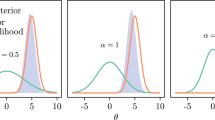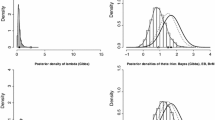Abstract
We develop objective Bayesian analysis for the linear regression model with random errors distributed according to the exponential power distribution. More specifically, we derive explicit expressions for three different Jeffreys priors for the model parameters. We show that only one of these Jeffreys priors leads to a proper posterior distribution. In addition, we develop fast posterior analysis based on Laplace approximations. Moreover, we show that our proposed Bayesian analysis compares favorably to a posterior analysis based on a competing noninformative prior. Finally, we illustrate our methodology with applications of the exponential power regression model to two different datasets.





Similar content being viewed by others
References
Abramowitz, M. and Stegun, I.A. (1972). Handbook of Mathematical Functions. Dover, New York.
Achcar, J.A. and Pereira, G.A. (1999). Use of exponential power distributions for mixture models in the presence of covariates. J. Appl. Stat., 26, 669–679.
Berger, J.O., De Oliveira, V. and Sansó, B. (2001). Objective Bayesian analysis of spatially correlated data. J. Amer. Statist. Assoc., 96, 1361–1374.
Box, G.E.P. and Tiao, G.C. (1962). A further look at robustness via Bayes’s theorem. Biometrika, 49, 419–432.
Box, G.E.P. and Tiao, G.C. (1992). Bayesian inference in statistical analysis. Wiley-Interscience.
Butler, R.J., Mcdonald, J.B., Nelson, R.D. and White, S.B. (1990). Robust and partially adaptive estimation of regression models. Rev. Econom. Statist., 72, 321–327.
Choy, S.T.B. and Smith, A.F.M. (1997). On robust analysis of a normal location parameter. J. R. Stat. Soc. Ser. B, 59, 463–474.
Datta, G.S., Ghosh, M. and Mukerjee, R. (2000a). Some new results on probability matching priors. Calcutta Statist. Assoc. Bull., 50, 179–192.
Datta, G.S., Mukerjee, R., Ghosh, M. and Sweeting, T.J. (2000b). Bayesian prediction with approximate frequentist validity. Ann. Statist., 28, 1414–1426.
DiCiccio, T.J. and Monti, A.C. (2004). Inferential aspects of the skew exponential power distribution. J. Amer. Statist. Assoc., 99, 439–450.
Ferreira, M.A.R. and De Oliveira, V. (2007). Bayesian reference analysis for Gaussian Markov random rields. J. Multivariate Anal., 98, 789–812.
Ferreira, M.A.R. and Suchard, M.A. (2008). Bayesian analysis of elapsed times in continuous-time Markov chains. Canad. J. Statist., 36, 355–368.
Ghosh, M. (2011). Objective priors: an introduction for frequentists. Statist. Sci., 26, 187–202.
Jeffreys, H. (1961). Theory of Probability. Oxford University Press, Oxford.
Kass, R.E. and Raftery, A.E. (1995). Bayes factor. J. Amer. Statist. Assoc., 90, 773–795.
Levine, D.M., Krehbiel, T.C. and Berenson, M.L. (2006). Business Statistics: A First Course. Pearson Prentice Hall.
Liang, F., Liu, C. and Wang, N. (2007). A robust sequential Bayesian method for identification of differentially expressed genes. Statist. Sinica, 17, 571–597.
Press, W.H., Flannery, B.P., Teukolsky, S.A. and Vetterling, W.T. (2007). Numerical Recipes in C: The Art of Scientific Computing, 3rd ed. Cambridge: Cambridge University Press.
Severini, T.A., Mukerjee, R. and Ghosh, M. (2002). On an exact probability matching property of right-invariant priors. Biometrika, 89, 952–957.
Tierney, L. and Kadane, J.B. (1986). Accurate approximations for posterior moments and marginal densities. J. Amer. Statist. Assoc., 81, 82–86.
Vianelli, S. (1963). La misura della variabilità condizionata in uno schema generale delle curve normali di frequenza. Statistica, 23, 447–474.
Walker, S.G. and Gutiérrez-Peña, E. (1999). Robustifying Bayesian Procedures. In Bayesian Statistics 6. Oxford University Press, New York.
Wasserman, L. (2000). Asymptotic inference for mixture models using data-dependent priors. J. R. Stat. Soc. Ser. B, 62, 159–180.
West, M. (1984). Outlier models and prior distributions in Bayesian linear regression. J. R. Stat. Soc. Ser. B, 46, 431–439.
West, M. (1987). On scale mixtures of normal distributions. Biometrika, 79, 646–648.
Zhu, D. and Zinde-Walsh, V. (2009). Properties and estimation of asymmetric exponential power distribution. J. Econometrics, 148, 86–99.
Acknowledgement
The work of Salazar was supported in part by a FAPERJ grant. The work of Ferreira was supported in part by National Science Foundation Grant DMS-0907064. The work of Migon was supported in part by CNPq and CAPES Grants. Part of this research was done while Salazar was a postdoctoral fellow at the Federal University of Rio de Janeiro. Part of this research was done while Ferreira was a visiting fellow at the Statistical and Applied Mathematical Sciences Institute (SAMSI). SAMSI is supported by National Science Foundation Grant DMS-0635449.
Author information
Authors and Affiliations
Corresponding author
A Appendix
A Appendix
Proof of Theorem 3.1
Using the results of Proposition 3.1 we have that
- –:
-
For independence Jeffreys prior \(\pi^{I_1}(\theta)\): marginal priors for β and (σ,p) are independent a priori such that \(\pi^{I_1}(\beta,\sigma,p) = \pi^{I_1}(\beta) \pi^{I_1}(\sigma,p)\) and
$$ \begin{array}{rll} \pi^{I_1}(\sigma,p)&& \propto \sqrt{I_{\sigma \sigma}I_{pp}-I_{\sigma p}^2} \propto \frac{1}{\sigma p}\left\{ \left(1 + \frac{1}{p}\right)\Psi'\left(1 + 1/p\right) - 1 \right\}^{1/2}, \\ \pi^{I_1}(\beta) && \propto \sqrt{\det(I_{\beta \beta})} \propto 1. \end{array} $$ - –:
-
For independence Jeffreys prior \(\pi^{I_2}(\theta)\): let us consider independence Jeffreys prior such that \(\pi^{I_2}(\theta) \propto \pi^{I_2}(\beta)\pi^{I_2}(\sigma)\pi^{I_2}(p)\), that is, taking each of these parameters as independent. Then, from the Fisher information matrix, \(\pi^{I_2}(\beta) \propto 1\), \(\pi^{I_2}(\sigma) \propto \sigma^{-1}\) and \(\pi^{I_2}(p) \propto p^{-3/2}(1+p^{-1})^{1/2}\{\Psi'(1+p^{-1})\}^{1/2}\). Thus,
$$ \pi^{I_2}(\beta,\sigma,p) \propto \frac{1}{\sigma p^{3/2}}\left\{ \left(1 + \frac{1}{p}\right)\Psi'\left(1 + \frac{1}{p}\right)\right\}^{1/2}. $$ - –:
-
For Jeffreys-rule prior: \(\pi^J(\beta,\sigma,p) \propto \sqrt{\det(I(\theta))} = \sqrt{I_{\sigma \sigma}I_{pp}-I_{\sigma p}^2}\sqrt{\det(I_{\beta \beta})}\) where \(\det(I_{\beta \beta}) \propto \left\{ {1}/{\sigma^2}\Gamma\left(1/p\right) \Gamma\left(2-1/p\right) \right\}^{k}\). Therefore,
$$ \pi^J(\beta,\sigma,p) \propto \frac{1}{\sigma^k}\left\{\Gamma\left(\frac{1}{p}\right)\Gamma\left(2-\frac{1}{p}\right) \right\}^{k/2}\pi^{I_1}(\sigma,p). $$
Proof of Lemma 3.2
Considering the integrated likelihood in (4.1), the integrated likelihood for p is
Let us define the following two functions:
where \(|\tilde{x}_l| = \max|x_{il}|\), C 1 = {β ∈ ℝ, C 2 = {β ∈ ℝand \(\beta^* = {\displaystyle\arg\min_{\beta}} \sum_{i=1}^{n}|y_i-x_i'\beta|^p\). Note that \(\sum_{i=1}^{n}|y_i-x_i'\beta^*|^p>0\) with probability 1 and, for example, if p = 2 then β * = (x′x) − 1 x′y.
Note the following:
-
(i)
$$ \begin{array}{rll} \sum\limits_{i=1}^{n}|y_i-x_i'\beta|^p &\leq& \sum\limits_{i=1}^{n}(|y_i|+|x_i'\beta|)^p \leq \sum\limits_{i=1}^{n}\left(\max|y_i|+\sum\limits_{l=1}^k|x_{il}|\, |\beta_l|\right)^p \\ &\leq& \sum\limits_{i=1}^{n}\left(\max|y_i|+\sum\limits_{l=1}^k|\tilde{x}_l|\, |\beta_l| \right)^p = h(\beta,p). \end{array} $$
-
(ii)
For p ≥ 1 the function |·|p is convex. Thus, by Jensen’s inequality
$$ \sum\limits_{i=1}^n|y_i-x_i'\beta|^p \geq n\left|1/n\sum\limits_{i=1}^n (y_i- x_i'\beta)\right|^p = n|\bar{y}-\bar{x}'\beta|^p. $$ -
(iii)
Consider β ∈ C 1. Using the definition of β * and result (ii) we have
$$ \sum_{i=1}^n|y_i - x_i'\beta|^p \geq \sum_{i=1}^n|y_i-x_i'\beta^*|^p \geq n|\bar{y}-\bar{x}'\beta^*|^p = g(\beta,p). $$ -
(iv)
Consider β ∈ C 2. Then by result (ii) we have
$$ \sum_{i=1}^n|y_i - x_i'\beta|^p \geq n|\bar{y}-\bar{x}'\beta|^p = g(\mu,p). $$ -
(v)
Thus, by results (iii) and (iv),
$$ \sum\limits_{i=^1}^n|y_i - x_i'\beta|^p \geq g(\beta,p). $$
Therefore, by results (i) and (v) above,
Let us now compute the left and right integral above. For the left integral and considering \(\beta_{(-j)} = (\beta_{j+1}, \ldots, \beta_k)' \in \mathbb{R}^{k-j}\) for j = 1, ..., k − 1 we have:
The integral above can be computed recursively for each element of the vector β ( − 1). The result is convergent as long as n > k + 1 − a, thus
where \(m_1(y) = \frac{2^k \Gamma(n+a-k-1)\{\max|y_i|\}^{-(n+a-1-k)}}{\Gamma(n+a-1) \prod_{l=1}^{k}|\tilde{x}_l|} > 0\), does not depend on p.
The right integral is
where \(m_2(y) = \int_{C_1} |\bar{y}-\bar{x}'\beta^*|^{-(n+a-1)}d\beta + \int_{C_2} |\bar{y}-\bar{x}'\beta|^{-(n+a-1)}d\beta\) does not depend on p.
Therefore, we have shown that for n > k + 1 − a
The result above will allow us to study the tail behavior of the integrated likelihood for p. First, note that from the series expansion of {Γ(z)} − 1 (Abramowitz and Stegun, 1972, p.256) we obtain that {Γ(z)} − 1 ≈ z from z close to 0. Thus, as p goes to ∞ we have Γ(1/p) ≈ p. In addition, considering the first-order Taylor expansion of logΓ(1 + z) around z = 0, logΓ(1 + z) ≈ Ψ(1)z, where Ψ(1) ≈ − 0.5772 is the digamma function evaluated at 1. Thus, \(\Gamma(1+1/p) \approx \mbox{e}^{-0.5772/p}\) for large p. Therefore, for p → ∞,
Rights and permissions
About this article
Cite this article
Salazar, E., Ferreira, M.A. & Migon, H.S. Objective Bayesian analysis for exponential power regression models. Sankhya B 74, 107–125 (2012). https://doi.org/10.1007/s13571-012-0045-0
Received:
Revised:
Published:
Issue Date:
DOI: https://doi.org/10.1007/s13571-012-0045-0




